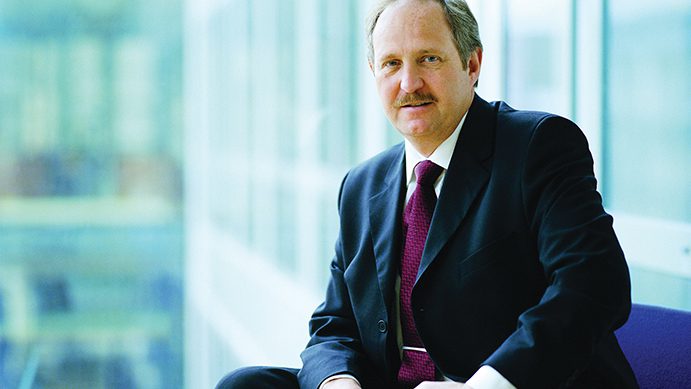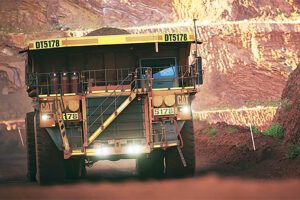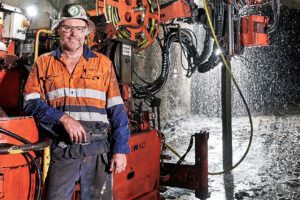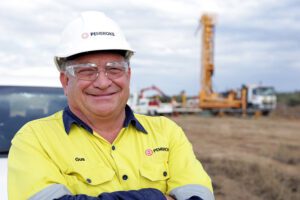CEO of IFS Alastair Sorbie talks technology disruption and how we should be embracing the new opportunities technology brings.
What are your thoughts on companies adopting new technologies?
Technology disruption is everywhere, and that is not limited to the resource industries. At the IFS world conference late last year in Boston, we kicked off with a series of videos illustrating the disruptive impact that technologies have played across a broad range of industries. We believe that identified and utilised effectively, these technologies can supercharge business growth.
I call it the Uber effect, a reference to the app which is quickly replacing traditional taxi cabs – devastating one sector but building a new one in its place. New operators like Uber are arriving all over the place, and in every industry, and it’s about seeing their innovations as an opportunity instead of a threat. People need to ask themselves, how can an industry like mining adapt and ride this wave of disruption?
The Internet of Things (IoT), autonomous vehicles, drones, and other technologies are becoming more prevalent in the mining industry. Should the industry be frightened of these innovations or should they be embracing them?
You’re right, there is a huge range of potentially disruptive technologies, many of which are now gaining traction. These include things like 3D printing, drones, next-generation batteries, hydrogen fuel cells, wearable devices and the Internet of Things.
Should the industry be frightened? Perhaps, because no industry is immune from the Uber effect. In the oil and gas industry, for example, companies are already springing up to offer unmanned aerial vehicle (UAV) services for offshore and onshore inspections. GE Oil & Gas already uses 3D printers to manufacture control valve parts used in the energy industry.
The industry has to embrace these changes – particularly now, when there is so much pressure coming from low commodity prices to lower the cost of production and maintain profitability over the long haul.
Are there any new technologies expected to be making an appearance in the mining industry?
People talk a lot about drones and driverless trucks, these are some very concrete examples of futuristic technologies coming on stream. But some of the new technologies that will make the biggest difference are a convergence of the old and the new.
For example, we’re now seeing visualisation technology coming to the fore – people representing mines and production plants and in 3D form and using that to drive interrogation of enterprise systems and data for better planning.
In many cases that takes away the need for you to be physically present on site and still get a chance to visualise the work occurring before executing it. By linking the model of a plant with ERP software, you can see the plant working. You can visualise new work occurring within the plant and sequence the planning for the work visually before you hit the work order. By using technology to do a dummy run of the work, you can avoid making costly mistakes.
That example ties in with existing Building Information Modelling (BIM) technology. Traditional use of BIM would be in the new construction phase. But we are now seeing it being used in the maintenance field. Even for assets that were not constructed using BIM, you can create an as-built BIM model and we have a couple of customers that have done this and are maintaining sophisticated plant. They want to use the models to create the efficiencies to give them an extra competitive advantage.
The downturn in resources means that new projects are scarce. But the maintenance projects are still there, and companies now want to sweat their existing mines and plants for longer, and that means making investments in long term maintenance programs. If suppliers want to win that work they have to demonstrate something that gives them a competitive edge. If you can increase efficiency you can make everything more profitable.
If I am doing maintenance work at height along an LNG train, for example, I would need to erect scaffolding and I need the work to follow across the line of the plant. Technology that allows you to optimise that sequence of work could allow you to more accurately predict the manpower required, and do it with fewer people.
These are enhancements of existing technologies that are being used in new and innovative ways. With new technology like the Internet of Things, we will also have all that measurement information coming into systems and giving you the ability to move to predictive maintenance. You won’t be relying on people to go out and physically read meters – that information will flow through automatically into your systems and trigger appropriate actions.
There is also the concept of the commoditisation of specialist labour. If I have systems which provide detailed and specific video instructions to a remote fitter onsite, they can do more sophisticated work. More people will be able to do the work required without as much detailed knowledge – they can be mentored with technology to assist them. You will also have access to expert help if required. An expert technician back at base could take advantage of wearable technology to see exactly what the on-site worker is seeing, and walk them through what needs to be done.
How are these technologies beneficial to safety, productivity and costs?
Let me give you a few examples:
The Internet of Things will also enable predictive maintenance. Assets from trucks to engines and pumps will send sensor readings back to service providers so they know precisely when they need to schedule visits to prevent breakdowns. Sensor data shared with equipment manufacturers not only supports future product innovation, it may enable them to better understand their clients’ needs and tailor solutions to their individual requirements.
With the increased use of sensor technology, resources companies will capture massive amounts of information about their operations. Provided they also improve their data quality, integrate their business intelligence systems, and apply machine learning algorithms, then they can mine this Big Data to make better decisions in real time.
Companies face constant problems losing track of assets which are taken off site. This may be simply for repairs but if the move is recorded manually and not visible in the company’s information system, it causes delays. With location sensors embedded in mobile assets, however, alarms can be automatically raised whenever they are moved off site, or when the numbers of a particular resource fall below the required level.
The productivity and safety of field workers will be greatly improved by wearable devices that monitor their working environment and connect them to systems and expert staff thousands of kilometres away.
Not only will expert staff sitting in offices thousands of kilometres away control onsite equipment and walk, drive or fly through models of the real thing, workers in the field will have new augmented reality tools giving them the equivalent of X-ray vision to enhance their productivity.
Wearable technology like Google Glass can improve the productivity of service technicians by allowing them to work hands free while referring to service manuals, engineering diagrams and other resources. If they get stuck trying to fix something, they can patch in remote engineering support who can see what they can see to advise them. There is also the potential for jobs to be recorded, with previous repairs recalled and replayed. Similar technology could allow heavy equipment operators to make their own repairs. Instead of having to shut down a crane when the hoist mechanism stops, for example, an expert could be patched in to see if a simple repair could be effected onsite.
The combination of wearable technology and augmented reality means that a wide range of tasks previously requiring skilled on-site staff can be broken down into on-site and remote components. Skilled resource workers will be able to extend their careers with jobs that no longer require travel to inhospitable environments.
What are you thoughts on taking the human element out of the workplace and replacing it with a machine, in regards to safety?
The challenge is not to completely remove the human element but rather how to make the best use of your people to improve efficiency. That means finding the right balance between automation and human intervention. You don’t want to leave a mine site so that it is never touched, for example. If you go for full automation you will open the door to systems failure because systems are programmed by people and people will make mistakes.
So you need to balance the level of automation with an appropriate level of human oversight so that you are not totally dependent on machine data. The human element always needs to be included. We don’t turn on automated systems and turn off the screen. We still need people to monitor the systems.
Why is supporting mobile devices and making software easy to use so important?
When you connect employees’ and contractors’ mobile devices with enterprise systems they can access and update data such as asset information in real time and share information throughout the enterprise to better utilise both assets and workforces. Mobile devices with inbuilt GPS can now run business apps for work orders, fault reports, confirmation of delivery routes, even work force scheduling and optimisation.
Being able to capture data and access information wherever you are, including a remote mine site, is absolutely key to managing operations in real time. Systems that can talk in real time to head office from any location improve decision making around when assets need to be repaired or replaced, for example, or whether there are too many people on site that could be redeployed elsewhere.
Without access to real-time information, the bottom line impact of operational decisions often only becomes apparent some time after the company compiles its end of month reports. It’s a bit like driving a car while looking in the rear-view mirror.
To achieve this, the software also needs to be intuitive and easy to navigate. This means that instead of memorising which screens to access, users should have a graphical, role-based interface that simplifies the top action items, workflows and metrics of interest. Making enterprise solutions easy to use is just as important as the ability to easily integrate new technologies. To be confident that your innovations will succeed you need to remove all barriers to their uptake and effective use.
Is there anything else you would like to touch on?
Commodities and resources are going through tough times. They have to leverage technology and move to lower cost operations. With innovation you can take advantage of new technologies like the Internet of Things and the convergence of existing technologies like enterprise software – but you have to be open to new ideas. The same old thing is not going to work any more, you need to look to your best and your brightest people who, for some companies, are going to make the difference between surviving and not.
You also have to decide what technologies and innovations are most important. In our experience, it’s the data that is going to have the biggest impact. With any innovation, you need to build that into your processes and support it in your enterprise systems so that it is efficient, repeatable and measurable.
The current wave of technological innovation carries a real danger of further fragmentation with more standalones and the creation of more information silos. Without a flexible enterprise information system capable of quickly and cost-effectively integrating new technologies, only isolated efficiency improvements will be achieved. And without a system that can consolidate information across business units and projects, it will be difficult to measure the exact impact that new technologies are having. You can’t improve what you can’t measure, and it’s nearly impossible to calculate the return on investment.
ABOUT ALASTAIR SORBIE
Alastair Sorbie has been CEO and President of global enterprise applications company IFS for 10 years. Before that, he was the founding managing director of IFS UK and IFS South Africa. He played an important role in IFS’s entry into project-based industries, such as engineering, construction and defence. The company was already very strong in the oil and gas industry, and the combination of project-based and resource industry experience has seen it enter the mining industry, particularly in countries like Australia.
Alastair also has experience in consultancy in the oil and gas industry, as well as those downstream industries like engineering and construction.













Add Comment